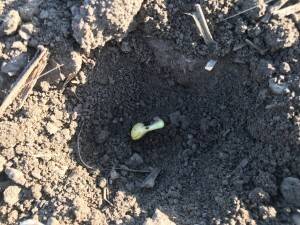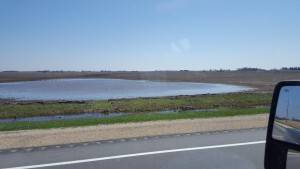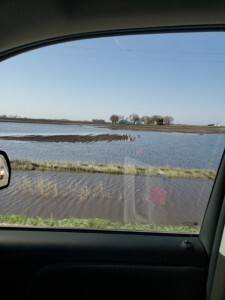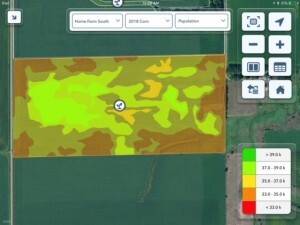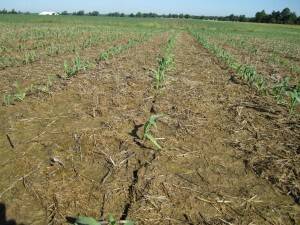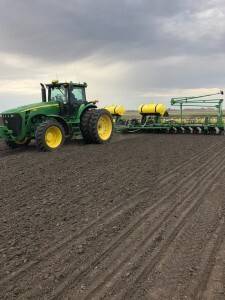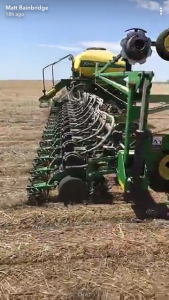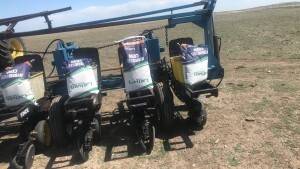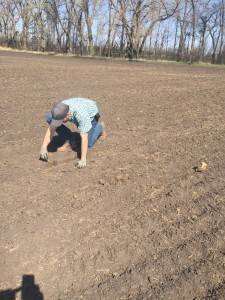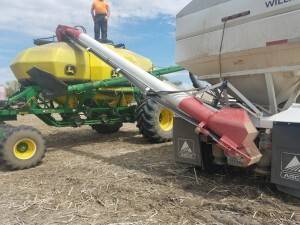EASTERN IOWA
Jerry Broders
This customer is finishing up corn planting by Center Point. Most growers in Eastern Iowa are winding down with corn and moving to soybeans.
CENTRAL IOWA
Bryan Rohe
Soybeans planted early in Central Iowa are confused, which is a sign of imbibitional chilling damage. “Confused seedlings” either emerge incorrectly or not at all because these seeds absorbed water when soil temperatures were less than 55° or 60° F for an extended period of time.
NORTHEAST IOWA & SOUTHEAST MINNESOTA
Craig Haaland
Soil temperatures are warm enough for planting, but we received 5 inches of rain last week. Many farmers held off planting when they saw rain was in the forecast, and that turned out to be a good decision for many. After four good days of drying conditions, we had hoped planters would get rolling on Tuesday. Very few soils were dry enough yesterday and then we received another 0.7” last night. We need more drying weather! We need fit soil conditions for best results.
WEST NORTH CENTRAL IOWA
Bart Peterson
This photo was taken on Thursday, May 4, about 4 miles east of Humboldt in West Central Iowa. Total rain fall last week in that area was 4 inches. Due to snow and rain the last two months, farmers in Humboldt County have maybe only 20% of their corn in the ground.
NORTH CENTRAL IOWA & SOUTH CENTRAL MINNESOTA
Cory Greiman
We’re seeing signs of winter kill. When alfalfa plants break dormancy, plants are susceptible to cold crown temperatures. Spring snowmelt, combined with late-season snow, may have frozen these plants. Other factors that affect winter kill include: stand age, alfalfa variety, soil pH, soil fertility and cutting management.
NORTHWEST IOWA
Darin Chapman
Northwest Iowa farmers are behind on planting due to continued rainfall. We are looking forward to performing multiple hybrid on-farm research. The photo shows a multi-hybrid and variable rate seeding prescription written with Latham Hi‑Tech Seed’s Data Forward Precision Ag Program. We are able to place two different hybrids (LH 4955 VT2 PRO and LH 5095 VT2 PRO) where they should show best performance on the right soil, at the right seeding rate.
WESTERN IOWA & EASTERN NEBRASKA
Larry Krapfl
Another field in Western Iowa is being planted with Latham® LibertyLink 3158 soybeans.
SOUTHERN WISCONSIN
Greg Mair
Field conditions in Wisconsin were good for planting lots of acres on Monday and Tuesday. We got two Latham® Corn SuperStrip plots planted: one in Cambridge and another in Watertown. SuperStrip plots are replicated trials of a specific hybrid sets for each maturity range. We use them to evaluate hybrids across Latham Hi‑Tech Seeds’ entire regional footprint to determine field-by-field placement, which helps our customers maximize profit on every acre.
SOUTHERN MINNESOTA
Jay Nelson
According to the latest planting report, corn planting is only 9 percent complete in Minnesota. That’s 9 days behind last year and 16 days behind the 5-year average, making some growers more focused on the calendar date rather than planting conditions. Keep in mind that we’re still well within optimal planting dates, so you can afford to wait for fit soils in order to avoid season-long problems. Wet soils are easily compacted, and sidewall compaction can lead to dramatic decreases in yield.
NORTHERN MINNESOTA
Ken Highness
May 8 has been our best day this spring in the Red River Valley with a high of 86 degrees! We planted a Latham® SuperStrip plot on the farm of our dealers Mike and Dave Bergquist.
SOUTHEAST SOUTH DAKOTA
Ramie Coughlin
Fields have finally dried off enough for planters to roll in full force for the past week. We have had some really nice high temperatures and a few very windy days to dry things out nicely. Right now most growers are focusing on corn. A few have planted soybeans, depending on what fields are ready to go. I expect to see a shift to beans start happening within the week.
NORTHEAST SOUTH DAKOTA
James Keltgen
Planting is progressing across Northeast South Dakota (NESD). With 4-inch soil temperatures around 49 degrees and the short-term forecast calls for warmer weather ahead, the first Latham SuperStrip went in May 8 at Clark. Growers along the James River Valley are planting in full force. Latham® corn is going in around West River, as well. Some area farmers have finished corn planting and are switching to soybeans. A little corn has been planted around Watertown, but fields here are wetter and are lagging behind. In the Milbank area, growers have been planting soybeans but frost is still coming out of the corn acres.
SOUTHEAST NORTH DAKOTA
Gary Geske
Planting depth is crucial for even emergence of seedlings. It’s important that you adjust planters at the beginning of the season – and all season long. As the planting season continues, monitor the settings. You may need to adjust it for every field as field conditions and other variables affect how the planter works. We recommend proper seed selection field-by-field, so it only makes sense to also check planter settings field-by-field.
EASTERN NORTH DAKOTA
Brian McNamee
The tractors, seeders and planters keep rolling. Scattered rain showers haven’t slowed down our planting progress. Actually, we could use a rain here. Farmers are chasing planting depth, and we could use more moisture before we continue planting alfalfa. Soybean planting got underway on Monday. We’re providing seed with a smile, right to the field and into the drill!

